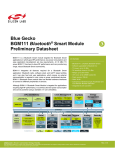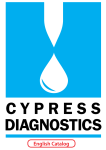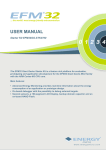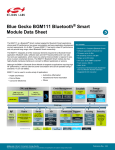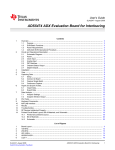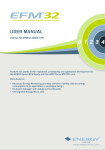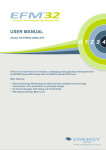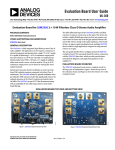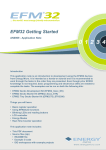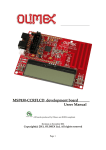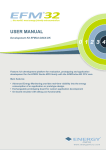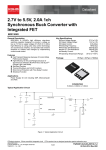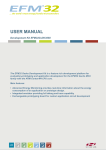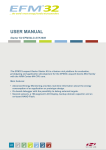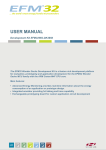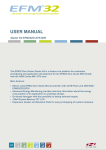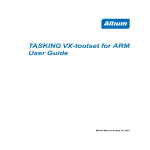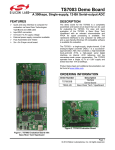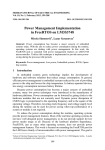Download USER MANUAL - ARM DS-5 Development Studio
Transcript
...the world's most energy friendly microcontrollers USER MANUAL Starter Kit EFM32TG-STK3300 Feature rich starter kit for evaluation, prototyping and application development for the EFM32TG MCU family with the ARM Cortex-M3 CPU core. Main features; • Advanced Energy Monitoring provides real-time visibility into the energy consumption of an application or prototype design. • On-board debugger with debug out functionality • 160-segment Energy Micro LCD ...the world's most energy friendly microcontrollers 1 Introduction 1.1 Features • • • • • • • • • • • Advanced Energy Monitoring system for precise current tracking. Special hardware configuration for isolation of the MCU power domain. Full feature USB debugger with debug out functionality. 160 segment Energy Micro LCD. 20 pin expansion header. Breakout pads for easy access to I/O pins. Powered by USB or CR2032 battery. 2 user buttons, 1 user LED and a touch slider. Ambient Light sensor and inductive-capacitive metal sensor. EFM32 Op-amp footprint. 32MHz and 32.768kHz crystal oscillators. 2011-05-13 - t0011_1.00 2 www.energymicro.com ...the world's most energy friendly microcontrollers 2 STK block diagram An overview of the Kit is shown in the block diagram below. Figure 2.1. EFM32TG-STK3300 Block Diagram + 3V CR2032 Touch slider 4 Reset 28 1 3 2 4 Debug In/Out EFM 3 2 2 1 Push buttons Am bient Light Sensor 20 LC sensor LED 1 1 Opam p Footprint 3 BC USB m ini B Breakout pads EXP 2011-05-13 - t0011_1.00 3 www.energymicro.com ...the world's most energy friendly microcontrollers 3 Hardware layout The layout of the EFM32TG-STK3300 is shown below. Figure 3.1. EFM32TG-STK3300 hardware layout 2011-05-13 - t0011_1.00 4 www.energymicro.com ...the world's most energy friendly microcontrollers 4 Power supply 4.1 USB The EFM32TG-STK3300 can get its power from the USB port. The MCU voltage will be 3.3 volts when USB is connected. 4.2 Battery There is a socket for a 20mm coin cell battery, which can be used to power the kit. When the battery connect switch position is towards the battery, the EFM and its peripherals is powered by the battery. The board controller/AEM is not powered by the battery, so the BSP software support library cannot be used without USB connected. The current consumption while running on battery will be zero since the battery supply is not part of the AEM. Note Make sure that the battery is inserted with the correct polarity. 2011-05-13 - t0011_1.00 5 www.energymicro.com ...the world's most energy friendly microcontrollers 5 Reset infrastructure 5.1 MCU The primary user reset for the EFM32 MCU is the reset button on the board. This will only reset the EFM32 MCU. The MCU can also be reset by the internal debugger or an external debugger. 5.2 Board controller The board controller can only be reset by pulling and reinserting the USB cable. While on battery power this will not reset the EFM32 MCU. 2011-05-13 - t0011_1.00 6 www.energymicro.com ...the world's most energy friendly microcontrollers 6 Peripherals The starter kit has a set of peripherals that showcase some of the features of the EFM32TG. Be aware that most EFM32 I/O routed to peripherals are also routed to the breakout pads. This must be taken into consideration when using the breakout pads for your application. 6.1 Pushbuttons The kit has two user pushbuttons marked PB0 and PB1. They are connected to the EFM32, and are debounced by RC filters with a time constant of 1ms. 6.2 LED There is one LED on the kit marked USER LED. An active high on the respective pin will light the LED. 6.3 LCD A 28-pin Energy Micro LCD display is connected to the EFM32. The LCD has 8 common lines and 20 segment lines. This gives a total of 160 segments in 8-plexed mode. These lines are not shared on the breakout pads. Capacitors for the EFM32TG LCD boost function is also available on the EFM32TGSTK3300. 6.4 Touch slider A touch slider utilizing the capacitive touch capability is available. It is placed under the two push buttons on the kit, above the "TOUCH SLIDER" print. 6.5 Ambient Light Sensor The kit has a light sensitive, transistor type, ambient light sensor connected to the low energy sensor interface of the EFM32TG MCU. The sensor is placed above the push buttons and can be used to sense changes in ambient light levels. 6.6 LC Sensor In the bottom right corner there is an inductive-capacitive sensor for demonstrating the low energy sensor interface. By setting up oscillating currents in the inductor, metal nearby the inductor can be sensed by measuring the oscillation decay time. The effective range is a few millimeters. 6.7 Op-Amp Footprint If the kit is flipped over there is a silk-print model of a typical operational amplifier feedback circuit. The actual operational amplifier is one of the op-amps inside the EFM32. By soldering 0603 sized resistors the EFM32 internal operational amplifier can be evaluated with exact resistor values. 2011-05-13 - t0011_1.00 7 www.energymicro.com ...the world's most energy friendly microcontrollers 7 Advanced Energy Monitor 7.1 Usage The AEM (Advanced Energy Monitor) data is collected by the board controller and can be displayed by the energyAware Profiler, available through Simplicity Studio. By using the energyAware Profiler, current consumption and voltage can be measured and linked to the actual code running on the EFM32 in realtime. 7.2 AEM theory of operation In order to be able to measure currents ranging from 0.1uA to 50mA (114dB dynamic range), two current sense amplifiers are utilized. The amplifiers measure voltage drop over a small series resistor and translates this into a current. Each amplifier is adjusted for current measurement in a specific range. The ranges for the amplifiers overlap and a change between the two occurs when the current is 200uA. To reduce noise, averaging of the samples is performed before the current measurement is presented in the AEM GUI. During startup of the kit, an automatic calibration of the AEM is performed. This calibration compensates for the offset error in the sense amplifiers. 7.3 AEM accuracy and performance The Advanced Energy Monitor is capable of measuring currents in the range of 0.1uA to 50mA. For currents above 200uA, the AEM is accurate within 0.1mA. When measuring currents below 200uA, the accuracy increases to 1uA. Even though the absolute accuracy is 1uA in the sub 200uA range, the AEM is able to detect changes in the current consumption as small as 100nA The measurement bandwidth of the AEM is 60Hz when measuring currents below 200uA and 120Hz when measuring currents above 200uA. The table below summarizes the accuracy of the two current sense amplifiers in different ranges. Table 7.1. AEM accuracy Current range Low gain amplifier accuracy High gain amplifier accuracy 50mA 0.1mA - 1mA 0.1mA - 200uA 0.01mA 1uA 10uA - 0.1uA 1uA - 0.1uA Note The current measurement will only be correct when powering the EFM32 from USB power. The battery switch should be in the position furthest away from the battery. 2011-05-13 - t0011_1.00 8 www.energymicro.com ...the world's most energy friendly microcontrollers 8 Board controller The control MCU can act as a board controller (BC). There is a UART connection between the EFM32 and the BC. The connection is made by setting the bc_en line high. The EFM32 can then use the BSP (Board Support Package) library functions to send commands to the BC. When bc_en is low, bc_tx and bc_rx can be used by other applications. To use the board controller for your application, the Board Support Package must be installed. See the BSP chapter to find out how. Note The board controller is only available when USB power is connected. 2011-05-13 - t0011_1.00 9 www.energymicro.com ...the world's most energy friendly microcontrollers 9 Board Support Package The Board Support Package (BSP) is a set of C source and header files that enables easy access to, and control over some board specific features. Compared to the Energy Micro development kit, the functionality is limited. Unless you need/want some of the functions contained in the BSP, there is really no need to include or use it. The EFM32 in the Starter Kit is fully usable without BSP support, and you can use all peripherals in the efm32lib without the BSP. The BSP use EFM32 peripheral USART1 (TX pin PD7, RX pin PD6) on baudrate 115200-8-N-1 to communicate with the board controller. Note The BSP is only functional when the Starter Kit is USB-powered, using these function calls with USB disconnected will give unpredictable results. 9.1 Installation location When installing Simplicity Studio, the BSP will be installed in the user directory, typically in a location such as Win7: C:\Users\[username]\AppData\Roaming\energymicro\boards or something similar (depending on your OS/Windows version). All files in the board support package is prefixed by stk. 9.2 Application Programming Interface To use the BSP, include the Starter Kit header file, like this: #include "stk.h" All functions in the BSP are prefixed with STK_. The main initialization routine is defined as void STK_Init(void); and must be called before any access to the STK-functions. This function call will setup the UART communication channel with a 115800 baud rate. This baud rate depends on the current core clock, so correct clock configuration should be set before calling this function. bool STK_Ready(void); Returns true if the board controller is responding. A non-responding board will either return false, or hang (i.e. if the EFM32 is powered by the CR2032 battery cell). float STK_Current(void); Returns instant current usage in milliamperes. float STK_Voltage(void); 2011-05-13 - t0011_1.00 10 www.energymicro.com ...the world's most energy friendly microcontrollers Returns instant voltage (VMCU) reading in volt. bool STK_EnergyMode(uint8_t em); Informs the board controller about the Energy Mode (sleep mode) we are going into. This information can be used by the board controller to present a richer visual graph for illustrating what the EFM32 is currently doing. In addition to these main functions, full documentation of the complete API is included in the Doxygen/ HTML documentation of the installed package. 9.3 Example Applications Under the EFM32_Gxxx_STK/examples folder in your installation directory, you will find an example program using the BSP, with corresponding project/Makefiles for the supported IDEs. 9.4 How to include in your own applications The easiest way to include the BSP in your application is to base your work on the example application that use the BSP. The following items are recommended for correct configuration: 1. Make sure you define the correct part number (i.e. EFM32TG840F32) as a preprocessor defined symbol 2. Make sure you define the correct part number (i.e. EFM32TG840F32) for your project file 3. Add and include the EFM32_CMSIS-files (startup_efm32.s, system_efm32.c, core_cm3.c) to your project 4. Add and include _all_ BSP package .c-files, with the stk-prefix to your project 5. Configure include paths to point at the CMSIS/CM3/CoreSupport and CMSIS/CM3/DeviceSupport/ EnergyMicro/EFM32 directories 6. Configure include paths to point to the EFM32_Gxxx_STK/bsp directory Make sure you call "STK_Init()" early at startup, and you should be all set. 2011-05-13 - t0011_1.00 11 www.energymicro.com ...the world's most energy friendly microcontrollers 10 Connectors 10.1 Breakout pads Most I/O except the LCD pins are routed to the breakout pads at the top and bottom edge of the kit. A 2.54mm (100 mil) pitch pin header can be soldered in place on the pads for easier access. Some of the breakout pads are not connected and therefore marked NC. The position of the connected pins are compatible with the EFM32G Gecko starter kit. Note Some of the breakout pads are shared by on-board EFM peripherals. The schematic must be consulted to make sure that it is OK to use a shared pin in your application. Figure 10.1. Breakout pads and layout diagram 3 3V U C VM C N C N 8 PD7 PD 6 PD D N G 5 PD4 PD 3 PD 2 PD 1 PD0 PD D N G 1 PD 2 1 PB1 1 PB D N G 4 PD C N 5V Debug header in/out 1 20 EXP header Am bient Light Sensor USB + 3V CR2032 V+ VMCU GND SWO Reset User LED EFM 3 2 TG8 4 0 QFN 6 4 PB0 PB1 J100 PC13 PC12 PC7 PC5 PC6 LC Sensor AEM Connector Touch Slider 12 O SWC SWD SW ST R # D N G 3 3 VCU VM 4 1 PCC N D N G C N 6 PC 2 PD4 PC C N C N C N 8 PD D N G C N C N C N C N D N G 14 PA 3 1 PA1 2 PA 5V 2011-05-13 - t0011_1.00 www.energymicro.com ...the world's most energy friendly microcontrollers 10.2 Expansion header A 20 pin expansion header can be used to connect plugin boards. This contains a selection of I/O, powers and ground. See the pinout in the table below. Table 10.1. Expansion header pinout I/O # # I/O GND 1 2 VMCU PC4 3 4 PD0 PC5 5 6 PD1 PC12 7 8 PD2 PC13 9 10 PD3 PB11 11 12 PD4 PB12 13 14 PD5 PD7 15 16 PD6 PD8 17 18 5V GND 19 20 3V3 2011-05-13 - t0011_1.00 13 www.energymicro.com ...the world's most energy friendly microcontrollers Table 10.2. Expansion header pin list EXP header pin number MCU GPIO pin Some MCU GPIO pin functions 1 GND Ground 2 VMCU MCU supply voltage 3 PC4 OPAMP_P0 #0 / LETIMER_OUT0 #3 / ACMP0_CH4 / LES_CH4 4 PD0 ADC0_CH0 / USART1_TX #1 / OPAMP_OUT2 #1 5 PC5 OPAMP_N0 #0 / LETIMER_OUT1 #3 / ACMP0_CH5 / LES_CH5 #0 6 PD1 ADC0_CH1 / TIMER0_CC0 #3 / USART1_RX #1 / OPAMP_OUT1ALT #4 7 PC12 CMU_CLKOUT0 #1 / ACMP1_CH4 / LES_CH12 #0 8 PD2 ADC0_CH2 / TIMER0_CC1 #3 / USART1_CLK #1 9 PC13 ACMP1_CH5 #0 / TIM1_CC0 #0 / TIM1_CC2 #4 / PCNT0_S0IN #0 / LES_CH13 #0 10 PD3 ADC0_CH3 / OPAMP_N2 #0 / TIM0_CC2 #3 / US1_CS #1 11 PB11 DAC0_OUT0 #0 / OPAMP_OUT0 #0 / TIM1_CC2 #3 / LETIM0_OUT0 #1 12 PD4 ADC0_CH4 / OPAMP_P2 #0 / LEU0_TX #0 13 PB12 DAC0_OUT1 #0 / OPAMP_OUT1 #0 / LETIM0_OUT1 #1 14 PD5 ADC0_CH5 / OPAMP_OUT2 #0 / LEU0_RX #0 15 PD7 ADC0_CH7 / OPAMP_N1 #0 / TIM1_CC1 #4 / I2C0_SCL #1 / LES_ALTEX1 #0 / ACMP1_O #2 16 PD6 ADC0_CH6 / OPAMP_P1 #0 / TIM1_CC0 #4 / I2C0_SDA #1 / LES_ALTEX0 #0 / ACMP0_O #2 17 PD8 CMU_CLKOUT1 #1 18 5V USB Power 19 GND Ground 20 3V3 3.3V board power 10.3 Debug connector This connector is used for Debug In and Debug Out (see Debug chapter). The pinout is described in the table. 2011-05-13 - t0011_1.00 14 www.energymicro.com ...the world's most energy friendly microcontrollers Table 10.3. Debug connector pinout Pin number Function Note 1 VTARGET Target voltage on the debugged application. 2 NC 3 /TRST 4 GND 5 TDI 6 GND 7 TMS/SWDIO 8 GND 9 TCK 10 GND 11 RTCK 12 GND 13 TDO/SWO 14 GND 15 /RESET 16 GND 17 PD This pin has a 100k pulldown. 18 Cable detect This signal must be pulled to ground by the external debugger or application for cable insertion detection. 19 PD This pin has a 100k pulldown. 20 GND 2011-05-13 - t0011_1.00 JTAG tap reset JTAG data in JTAG TMS or Serial Wire data I/O JTAG TCK or Serial Wire clock JTAG RTCK JTAG TDO or Serial Wire Output Target MCU reset 15 www.energymicro.com ...the world's most energy friendly microcontrollers 11 Debugging The EFM32TG-STK3300 has an on-board debugger, and it can be used in different ways to debug the EFM32, both on and off kit. Below are descriptions on the different modes. Check the configuration chapter to find out how to change the debug setting. Table 11.1. Debug modes Mode Description Debug MCU In this mode the on-board debugger is connected to EFM32 on the EFM32TG-STK3300. Debug IN In this mode the on-board debugger is disconnected, and an external debugger can be connected to debug the EFM32 on the EFM32TG-STK3300. Debug OUT In this mode the on-board debugger can be used to debug an EFM32 mounted in your own application. 11.1 Debugging during battery operation When the EFM32 is powered by the battery and the USB is still connected, the on-board debug functionality is available. If the USB power is disconnected the debug controller on the kit will not work. To enable debugging in this mode, connect an external debugger (e.g. another EFM32TG-STK3300) to the debug pads in the bottom right corner of the EFM32TG-STK3300. These pads are connected directly to the EFM32 debug interface. 2011-05-13 - t0011_1.00 16 www.energymicro.com ...the world's most energy friendly microcontrollers 12 Integrated Development Environments The Energy Micro software packages contains various examples in source form to use with the Starter Kit. The following IDEs are supported. 12.1 IAR Embedded Workbench for ARM An evaluation version of IAR Embedded Workbench for ARM is included on a CD in the EFM32TGSTK3300 package. Check the quick start guide for where to find updates, and IAR's own documentation on how to use it. You will find the IAR project file in the iar subfolder of each project 12.2 Rowley Associates - CrossWorks for ARM See the quick start guide for download details for CrossWorks for ARM. You will find CrossWorks project files in the rowley subfolder of each project. 12.3 CodeSourcery - Sourcery G++ See the quick start guide for download details for Sourcery G++. The codesourcery subfolder contains Makefiles for use with the Sourcery G++ development environment. 12.4 Keil - MDK-ARM See the quick start guide for download details for evaluation versions of Keil MDK-ARM. The arm subfolder in each project contains project files for MDK-ARM. Please see the MDK-ARM documentation for usage details. 2011-05-13 - t0011_1.00 17 www.energymicro.com ...the world's most energy friendly microcontrollers 13 energyAware Commander and Upgrades The energyAware Commander is a program that comes with Simplicity Studio. It can perform various kit and EFM32 specific tasks. 13.1 eA Commander Operation This utility gives the ability to program the EFM32, upgrade the kit, lock and unlock devices and more. Some of the features will only work with Energy Micro kits, while other will work with a J-Link debugger connected. Press the "F1" button, or select the "Help->Help" menu item for a full description. 13.2 Upgrades Upgrading the kit is done through Simplicity Studio. The Studio will automatically check for new updates on startup. You can also use the energyAware Commander for manual upgrades. Select the "Kit" icon, use the "Browse" button to select the correct file ending in ".emz", and press the "Install package button". 2011-05-13 - t0011_1.00 18 www.energymicro.com ...the world's most energy friendly microcontrollers 14 Errata The following sections lists the erratas and known issues for operating the STK. You can read the STK revision on the white label on the back side of the STK. It is in the format "BRD2100, Rev: Axx". 14.1 Chip errata You can use energyAware Commander and press the "Connect" button to retrieve EFM32 revision information. Download the chip errata from http://www.energymicro.com for the latest errata updates on your device. 14.2 efm32lib Chip Init routine The efm32lib #include "efm32_chip.h" CHIP_Init() routine will, as far as possible, enable work arounds for chip erratas to make EFM32 Tiny Gecko devices be as software compatible as possible. In some cases, this can introduce increased current. See the device errata and source code for details. 14.3 STK Revision Errata Table 14.1. BRD2100 Revision Errata Revision Problem Description . . . 2011-05-13 - t0011_1.00 19 www.energymicro.com ...the world's most energy friendly microcontrollers 15 Version information The current version information can be read from Gecko Commander. Table 15.1. Current versions Type Version Released Firmware revision 1.5.0 13.05.2011 Board BRD2100A Rev. A03 13.05.2011 2011-05-13 - t0011_1.00 20 www.energymicro.com ...the world's most energy friendly microcontrollers 16 Schematic On the next pages you can find the schematic of the board. Figure 16.1. Schematic Page 1 2011-05-13 - t0011_1.00 21 www.energymicro.com ...the world's most energy friendly microcontrollers Figure 16.2. Schematic Page 2 2011-05-13 - t0011_1.00 22 www.energymicro.com ...the world's most energy friendly microcontrollers Figure 16.3. Schematic Page 3 2011-05-13 - t0011_1.00 23 www.energymicro.com ...the world's most energy friendly microcontrollers Figure 16.4. Schematic Page 4 2011-05-13 - t0011_1.00 24 www.energymicro.com ...the world's most energy friendly microcontrollers Figure 16.5. Schematic Page 5 2011-05-13 - t0011_1.00 25 www.energymicro.com ...the world's most energy friendly microcontrollers Figure 16.6. Schematic Page 6 2011-05-13 - t0011_1.00 26 www.energymicro.com ...the world's most energy friendly microcontrollers Figure 16.7. Schematic Page 7 2011-05-13 - t0011_1.00 27 www.energymicro.com ...the world's most energy friendly microcontrollers Figure 16.8. Schematic Page 8 2011-05-13 - t0011_1.00 28 www.energymicro.com ...the world's most energy friendly microcontrollers Figure 16.9. Schematic Page 9 2011-05-13 - t0011_1.00 29 www.energymicro.com ...the world's most energy friendly microcontrollers Figure 16.10. Schematic Page 10 2011-05-13 - t0011_1.00 30 www.energymicro.com ...the world's most energy friendly microcontrollers 17 Assembly Drawing On the next pages you can find the assembly drawings of the board (not to scale). Figure 17.1. Assembly Drawing Page 1 2011-05-13 - t0011_1.00 31 www.energymicro.com ...the world's most energy friendly microcontrollers Figure 17.2. Assembly Drawing Page 2 2011-05-13 - t0011_1.00 32 www.energymicro.com ...the world's most energy friendly microcontrollers 18 Bill of Materials On the next pages you can find the Bill of Materials for the board. Table 18.1. Bill of Materials Qty. Reference Manufacturer Manufacturers Part Number 7 C100,C101,C708,C709,C712,C713,C718 Murata 1N 1 C198 Murata 330P 50V C0G GRM155 39 C199,C401,C402,C403,C404,C408,C600,C603,... Murata 100N 16V X7R GRM155 3 C400,C501,C716 Murata 1U 12 C407,C409,C601,C700,C703,C714,C719,C720,... Murata 10U 10V X5R GRM21 6 C410,C411,C890,C905,C908,C909 Murata 10N 16V X7R GRM155 4 C412,C413,C902,C903 Murata 12P 50V C0G GCM155 2 C414,C415 Murata 22P 50V C0G GCM155 1 C500 Murata 22N 16V X7R GRM155 2 C602,C705 Murata 33N 16V X7R GRM155 2 C900,C901 Murata 18P 50V C0G GCM155 1 D600 NXP Semiconductors IP4220CZ6,125 1 D703 National LM4040CIM3-3.0 1 D800 Vishay Semiconductors VESD05A8A-HNH 1 LCD1 Tri-T Co Ltd CL010-1087-03 3 LED100,LED900,LED902 Everlight EL-19-21UYC/S530-A2/TR8 1 LED901 Panasonic LNJ926W8CRA 1 LED903 Everlight 19-21SDRC/S530-A3/TR8 1 L100 Bourns 390UH 9 L400,L660,L700,L701,L730,L780,L800,L801,... Murata BLM21B102S 1 L600 Murata BLM41P600S 1 PCB1 1 P100 Taitek HE2-20G6C394-5R 1 P601 Hirose Electric Co Ltd UX60-MB-5ST 1 P700 Keystone 3002 1 P800 3M D2520-6V0C-AR-WE 1 Q100 Vishay TEMT6200FX01A 1 Q702 ON Semiconductor BC846BWT1G 2 RP800,RP801 ROHM MNR04M0APJ330 6 R100,R103,R401,R730,R750,R810 100R 11 R101,R102,R680,R681,R682,R686,R687,R708,... 1M 5 R190,R900,R903,R905,R912 2K 15 R195,R197,R198,R704,R719,R721,R771,R773,... 0R 2 R196,R901 1K5 2 R199,R706 22K 2 R241,R242 0R 4 R400,R717,R724,R910 1R 10 R600,R609,R612,R700,R713,R714,R715,R716,... 10K 2011-05-13 - t0011_1.00 16V X7R 10V X5R GRM155 GRM18 SDR0302-391KL PCB2100 Rev. A03 33 www.energymicro.com ...the world's most energy friendly microcontrollers Qty. Reference 2 R601,R702 180K 2 R602,R703 110K 9 R603,R604,R605,R606,R729,R802,R803,R804,... 100K 6 R607,R608,R660,R774,R807,R808 4K7 2 R610,R814 10M 1 R611 180K 1 R701 3 R705,R728,R772 1K 3 R707,R727,R801 47K 1 R709 1K8 0.1% 1 R710 43R 0.1% 1 R711 4R7 0.1% 1 R712 0R 1 R718 12K 0.1% 1 R720 10K 0.1% 1 R760 10M 1% 3 R781,R805,R806 33R 2 R902,R904 22R 3 SW100,SW101,SW400 Omron Electronics B3S1000 1 SW700 C&K Components JS202011SCQN 2 U600,U701 National Semiconductor LP3982ILDX-ADJ 1 U601 Microchip 24AA024-I/MS 4 U602,U695,U702,U805 Texas Instruments TS3A4751RUCR 3 U660,U803,U804 NXP 74LVC2G125DC 1 U700 Texas Instruments TS5A3159ADBVR 2 U703,U705 National Semiconductor LTC6102CDD#PBF 1 U704 Texas Instruments TLV272CDGK 3 U706,U707,U850 Microchip Technology MCP6001T-I/OT 3 U800,U802,U806 NXP 74LVC4066BQ 1 U801 Texas Instruments 74LVC16T245DGG 1 U902 Numonyx M25PX16-VMP6E 1 U904 Energy Micro EFM32TG840 1 X400 NDK NX5032GA-32.000M 1 X401 Golledge GSWX-26 1 X900 NDK NX5032GA-16.000000MHZ 2011-05-13 - t0011_1.00 Manufacturer Bourns 34 Manufacturers Part Number 4R7 0.1% CRT1206-BY-4R7-ELFTR 0.1% www.energymicro.com ...the world's most energy friendly microcontrollers 19 Document Revision History 19.1 Revision 1.00 2011-05-13 Initial revision. 2011-05-13 - t0011_1.00 35 www.energymicro.com ...the world's most energy friendly microcontrollers A Disclaimer and Trademarks A.1 Disclaimer Energy Micro AS intends to provide customers with the latest, accurate, and in-depth documentation of all peripherals and modules available for system and software implementers using or intending to use the Energy Micro products. Characterization data, available modules and peripherals, memory sizes and memory addresses refer to each specific device, and "Typical" parameters provided can and do vary in different applications. Application examples described herein are for illustrative purposes only. Energy Micro reserves the right to make changes without further notice and limitation to product information, specifications, and descriptions herein, and does not give warranties as to the accuracy or completeness of the included information. Energy Micro shall have no liability for the consequences of use of the information supplied herein. This document does not imply or express copyright licenses granted hereunder to design or fabricate any integrated circuits. The products must not be used within any Life Support System without the specific written consent of Energy Micro. A "Life Support System" is any product or system intended to support or sustain life and/or health, which, if it fails, can be reasonably expected to result in significant personal injury or death. Energy Micro products are generally not intended for military applications. Energy Micro products shall under no circumstances be used in weapons of mass destruction including (but not limited to) nuclear, biological or chemical weapons, or missiles capable of delivering such weapons. A.2 Trademark Information Energy Micro, EFM32, EFR, logo and combinations thereof, and others are the registered trademarks or trademarks of Energy Micro AS. ARM, CORTEX, THUMB are the registered trademarks of ARM Limited. Other terms and product names may be trademarks of others. 2011-05-13 - t0011_1.00 36 www.energymicro.com ...the world's most energy friendly microcontrollers B Contact Information B.1 Energy Micro Corporate Headquarters Postal Address Visitor Address Technical Support Energy Micro AS P.O. Box 4633 Nydalen N-0405 Oslo NORWAY Energy Micro AS Sandakerveien 118 N-0484 Oslo NORWAY support.energymicro.com Phone: +47 40 10 03 01 www.energymicro.com Phone: +47 23 00 98 00 Fax: + 47 23 00 98 01 B.2 Global Contacts Visit www.energymicro.com for information on global distributors and representatives or contact [email protected] for additional information. Americas Europe, Middle East and Africa Asia and Pacific www.energymicro.com/americas www.energymicro.com/emea 2011-05-13 - t0011_1.00 37 www.energymicro.com/asia www.energymicro.com ...the world's most energy friendly microcontrollers Table of Contents 1. Introduction .............................................................................................................................................. 2 1.1. Features ....................................................................................................................................... 2 2. STK block diagram .................................................................................................................................... 3 3. Hardware layout ........................................................................................................................................ 4 4. Power supply ........................................................................................................................................... 5 4.1. USB ............................................................................................................................................. 5 4.2. Battery .......................................................................................................................................... 5 5. Reset infrastructure ................................................................................................................................... 6 5.1. MCU ............................................................................................................................................ 6 5.2. Board controller .............................................................................................................................. 6 6. Peripherals ............................................................................................................................................... 7 6.1. Pushbuttons ................................................................................................................................... 7 6.2. LED ............................................................................................................................................. 7 6.3. LCD ............................................................................................................................................. 7 6.4. Touch slider ................................................................................................................................... 7 6.5. Ambient Light Sensor ...................................................................................................................... 7 6.6. LC Sensor ..................................................................................................................................... 7 6.7. Op-Amp Footprint ........................................................................................................................... 7 7. Advanced Energy Monitor ........................................................................................................................... 8 7.1. Usage ........................................................................................................................................... 8 7.2. AEM theory of operation .................................................................................................................. 8 7.3. AEM accuracy and performance ........................................................................................................ 8 8. Board controller ........................................................................................................................................ 9 9. Board Support Package ............................................................................................................................ 10 9.1. Installation location ........................................................................................................................ 10 9.2. Application Programming Interface ................................................................................................... 10 9.3. Example Applications ..................................................................................................................... 11 9.4. How to include in your own applications ............................................................................................ 11 10. Connectors ........................................................................................................................................... 12 10.1. Breakout pads ............................................................................................................................ 12 10.2. Expansion header ........................................................................................................................ 13 10.3. Debug connector ......................................................................................................................... 14 11. Debugging ............................................................................................................................................ 16 11.1. Debugging during battery operation ................................................................................................ 16 12. Integrated Development Environments ....................................................................................................... 17 12.1. IAR Embedded Workbench for ARM ............................................................................................... 17 12.2. Rowley Associates - CrossWorks for ARM ....................................................................................... 17 12.3. CodeSourcery - Sourcery G++ ....................................................................................................... 17 12.4. Keil - MDK-ARM ......................................................................................................................... 17 13. energyAware Commander and Upgrades ................................................................................................... 18 13.1. eA Commander Operation ............................................................................................................. 18 13.2. Upgrades ................................................................................................................................... 18 14. Errata .................................................................................................................................................. 19 14.1. Chip errata ................................................................................................................................. 19 14.2. efm32lib Chip Init routine .............................................................................................................. 19 14.3. STK Revision Errata .................................................................................................................... 19 15. Version information ................................................................................................................................ 20 16. Schematic ............................................................................................................................................ 21 17. Assembly Drawing ................................................................................................................................. 31 18. Bill of Materials ..................................................................................................................................... 33 19. Document Revision History ...................................................................................................................... 35 19.1. Revision 1.00 .............................................................................................................................. 35 A. Disclaimer and Trademarks ....................................................................................................................... 36 A.1. Disclaimer ................................................................................................................................... 36 A.2. Trademark Information ................................................................................................................... 36 B. Contact Information ................................................................................................................................. 37 B.1. Energy Micro Corporate Headquarters .............................................................................................. 37 B.2. Global Contacts ............................................................................................................................ 37 2011-05-13 - t0011_1.00 38 www.energymicro.com ...the world's most energy friendly microcontrollers List of Figures 2.1. EFM32TG-STK3300 Block Diagram ........................................................................................................... 3 3.1. EFM32TG-STK3300 hardware layout .......................................................................................................... 4 10.1. Breakout pads and layout diagram ......................................................................................................... 12 16.1. Schematic Page 1 ............................................................................................................................... 21 16.2. Schematic Page 2 ............................................................................................................................... 22 16.3. Schematic Page 3 ............................................................................................................................... 23 16.4. Schematic Page 4 ............................................................................................................................... 24 16.5. Schematic Page 5 ............................................................................................................................... 25 16.6. Schematic Page 6 ............................................................................................................................... 26 16.7. Schematic Page 7 ............................................................................................................................... 27 16.8. Schematic Page 8 ............................................................................................................................... 28 16.9. Schematic Page 9 ............................................................................................................................... 29 16.10. Schematic Page 10 ............................................................................................................................ 30 17.1. Assembly Drawing Page 1 .................................................................................................................... 31 17.2. Assembly Drawing Page 2 .................................................................................................................... 32 2011-05-13 - t0011_1.00 39 www.energymicro.com ...the world's most energy friendly microcontrollers List of Tables 7.1. AEM accuracy ........................................................................................................................................ 8 10.1. Expansion header pinout ...................................................................................................................... 13 10.2. Expansion header pin list ...................................................................................................................... 14 10.3. Debug connector pinout ........................................................................................................................ 15 11.1. Debug modes ..................................................................................................................................... 16 14.1. BRD2100 Revision Errata ..................................................................................................................... 19 15.1. Current versions .................................................................................................................................. 20 18.1. Bill of Materials ................................................................................................................................... 33 2011-05-13 - t0011_1.00 40 www.energymicro.com









































